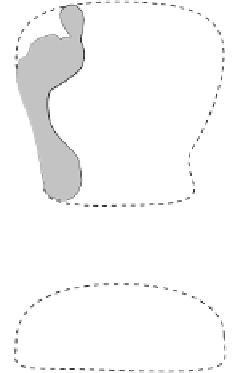Biomedical Engineering Reference
In-Depth Information
Fig. 3.2
(
a
) Illustration of
the projection (X) of the
center of gravity, C.G., of a
person standing erect, over
the area delimited by the
position of his or her feet.
(
b
) The same over an area of
support delimited by the tip
of the feet
a
X
b
X
and downward (more precisely, directed toward the center of earth), we just need to
see if its lever arm is zero or not. If it is different from zero, there is torque, and
hence rotation which can be clockwise or counterclockwise. When the line of action
of the weight force passes through the axis of rotation, the lever arm is zero and
there will be no torque, and the body will remain at the same position in static
equilibrium. It is worthwhile to note that the support force or the normal force does
not exert torque, since it acts just at the point of support and therefore the lever arm
is null. However, the support guarantees the equilibrium against translational
motion because the net force applied to the body constituted by the weight and
normal force is zero.
For a body to be in rotational equilibrium, an imaginary vertical line, passing
through its C.G., must pass through the area delimited by the support points.
In the case of a person standing erect with both feet equally sustained by the
ground, the area that delimits the points of support involves both feet, as illustrated
in Fig.
3.2a
. Figure
3.2b
shows the area of support of the same person on the tip of
the feet. The stability will be greater the larger is this area. This is the reason that it
is difficult to remain in equilibrium standing on tiptoe or on the tiptoe of a single
foot, as the area of support is much smaller.
An important observation related to the position of the center of gravity is that it
can be located outside the body, since it is a function of its mass distribution, as will
be seen later on. This was illustrated in Fig.
3.1a, b
for an acrobat and an inclined
chair, respectively.
Observe further that if the center of gravity is below the point of support, a
situation of great stability is achieved, as the torque caused by the weight produces
an oscillation that, when damped, leads to equilibrium with the point of support and
the center of gravity aligned vertically. Figure
3.3
shows a plastic bird with its
wings well opened, in equilibrium, supported by its beak. It is due to the lead




















